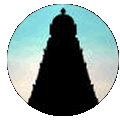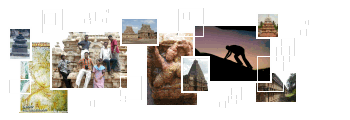 |
 |
 |
http://www.varalaaru.com A Monthly Web Magazine for South Asian History [187 Issues] [1839 Articles] |
 |
 |
 |
http://www.varalaaru.com A Monthly Web Magazine for South Asian History [187 Issues] [1839 Articles] |
|
Issue No. 18

இதழ் 18 [ டிசம்பர் 16, 2005 - ஜனவரி 15, 2006 ] 
இந்த இதழில்.. In this Issue.. 
|
Back to Mayavaram
Meeting Thyagaraja was indeed an inspiring experience for Gopalakrishna Bharathi. After his return to Mayavaram, there was a notable increase in his composing frequency. Some vidwans of Mayavaram requested Bharathi to compose kirtanas like Thyagaraja's famous Pancharatna Krithis. Bharathi obliged and composed songs in the five Ghana ragars, viz. Nattai, Varali, Gowlai, Arabhi and Sri1. One of those compositions is given below. Raga: Nattai Hara hara siva sankara karuNaakara paramEsvara aanandhath thaaNdavaraayaa (hara hara) purahara vrusha pathvaja paripUrNa kaama (hara hara) paramaanandha koobamum panchaatcharap padiyum kodiyum varamaruL sannadhiyum sivagangaiyum mathilum paravidun gOpaalakrishNan paadiya kujithapathamum darisanam paNNith theLindhidaadha janmam manitha janmamalla (hara hara) The above song was written as a tamil equivalent2 for Thyagaraja's "jagadhaa nandha". I have listened to other songs in this set, viz. "saraNaagathi enRu nimbi vandhEn" in Gowlai, "maRavaamal eppadiyum ninai manamE" in Sri. "piRavaadha mukthiyai thaarum" in Arabhi. While Thyagaraja's kirtanas were soaked with 'rama bhakthi', Bhyarathi's kirtanas sung the praise of Shiva. This delighted saivaites. His kirtanas, having a simple structure and based on the native language, tamil, became popular instantaneously. Bharathi's Students: Bharathi had a few students under his tutelage. They learnt his kirtanas and sung them at every given opportunity, much to their delight and the delight of the public. Some of the notable disciples of Bharathi are Chidambaram Ponnusamy Dikshithar, Chidarambaram Sri Rajarathna Dikshitar, Mayavaram Ramasamy Iyer, Natesa Iyer and Subramanya Iyer. Bharathi frequently visited Chidambaram to worship Lord Nataraja. During his visits, the Lord would invariably be adorned with his new compositions. In due course, the frequency of the visits saw an increase and his devotion to Nataraja reached a level that he would stay in Chidambaram for months. During such stays, he would stay at his disciple Ponnusamy Diskshitar's place in the eastern wing of the east veedhi (keezhai veedhi). Sivasankara Dikshithar: Sivasankara Dikshathar, an old man from the Dikshithar community, had immense bhakthi on Lord Shiva and was good in singing and composing. He would dance everyday at the Nataraja Shrine, holding a sivalinga made of rudraksha on his head, decorating himself with a 'vaagu maalai' and a 'gajjai3'. He has composed4 several songs on Lord Nataraja. Dikshitar's bhakthi and music attracted Bharathi towards him. Dikshithar too was impressed with Bharathi's bhakthi, gnana and music. This mutual admiration developed a close friendship between the too. Their relationship can be described appropriately from a quote in PuranaanooRu, "saanROr saanROr paalaraaba". Thanks to relationship with Dikshithar, Bharathi considered his stay in Chidambaram as a stay in "Shiva lOka" and his relationship with Dikshithar was comparable to a relationship with "Shiva kaNaas". Nandhanar Statue: During his stay in Chidambaram, he would visit the temple and perform 'japa' in front of the 'Urdhuva thaaNdava mUrthi' in the outer mandapa of the 'Nruththa sabha', located south of the 'Pon ambalam'. Sometimes, he would sing for hours sitting near the Nandhanar statue, located in the southern wall of the mandapa. The statue is placed in a position that it could directly see the Lord dancing in the 'pon ambalam'. The nandhanar statue holds a 'crow bar' in its hand and carries a 'maN vetti' in its shoulder. The icon was instrumental in developing Bharathi's adoration for Nadhanar's bhakthi. Onece, when Bharathi was singing there, a few of the listeners approached him and requested him to compose a song describing Nandhanar's wish of wanting to see the Lord from his shrine. Bharathi obliged and composed a song in raga Arabhi5. The pallavi line for the song is " ennEramum6 unRan sannadhiyil naan irukka vENdumaiyaa". Footnotes: 1. I've followed the same order of Ghana ragas described by Dr. U.Ve.Sa in his book. Not sure if this order has any significance. 2. Although, Dr. U.Ve.Sa says that these songs were like the tamil equivalent to Thyagaraja's pancharathna, except for the raga, the kirthana structure doesn't substantiate this. 3. Gajjai, when worn in the leg and danced would produce the intended 'sol kattus' of the dancer. 4. Dr. U.Ve.Sa, in his footnote, mention that his kirtanas have been published as a book 5. Interestingly, this song is sung in Devagandhari these days. 6. U.Ve.Sa, in his footnote, mentions that this song was not composed as a part of "nandhanar sarithra kithanaigaL". Publications of the later date have included this song in that set. this is txt file� |

சிறப்பிதழ்கள் Special Issues 

புகைப்படத் தொகுப்பு Photo Gallery 
|
| (C) 2004, varalaaru.com. All articles are copyrighted to respective authors. Unauthorized reproduction of any article, image or audio/video contents published here, without the prior approval of the authors or varalaaru.com are strictly prohibited. | ||